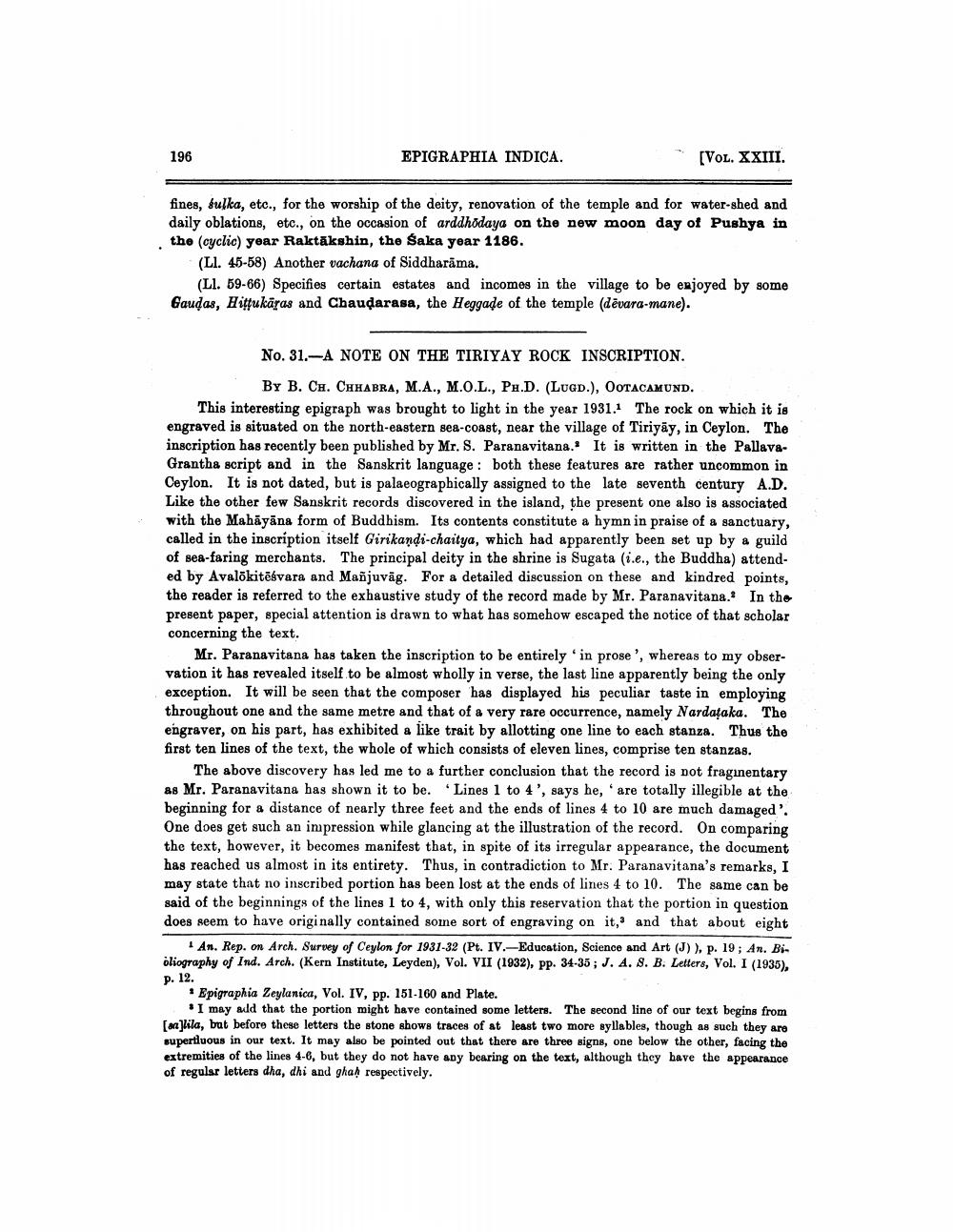________________
196
EPIGRAPHIA INDICA.
(Vol. XXIII.
fines, bulka, etc., for the worship of the deity, renovation of the temple and for water-shed and daily oblations, etc., on the occasion of arddhodaya on the new moon day of Pushya in the (cyclic) year Raktākshin, the Saka year 1186.
(Ll. 45-58) Another vachana of Siddharāma.
(Ll. 59-66) Specifies certain estates and incomes in the village to be enjoyed by some Gaudas, Hitfukāras and Chaudarasa, the Heggade of the temple (dēvara-mane).
No. 31.-A NOTE ON THE TIRIYAY ROCK INSCRIPTION.
BY B. CH. CHHABRA, M.A., M.O.L., Ph.D. (LUGD.), OOTACAMUND. This interesting epigraph was brought to light in the year 1931.1 The rock on which it is engraved is situated on the north-eastern sea-coast, near the village of Tiriyāy, in Ceylon. The inscription has recently been published by Mr. S. Paranavitana. It is written in the PallavaGrantha script and in the Sanskrit language : both these features are rather uncommon in Ceylon. It is not dated, but is palaeographically assigned to the late seventh century A.D. Like the other few Sanskrit records discovered in the island, the present one also is associated with the Mahāyāna form of Buddhism. Its contents constitute a hymn in praise of a sanctuary, called in the inscription itself Girikandi-chaitya, which had apparently been set up by a guild of sea-faring merchants. The principal deity in the shrine is Sugata (i.e., the Buddha) attended by Avalokitēśvara and Maõjuvāg. For a detailed discussion on these and kindred points, the reader is referred to the exhaustive study of the record made by Mr. Paranavitana.? In the present paper, special attention is drawn to what has somehow escaped the notice of that scholar concerning the text.
Mr. Paranavitana has taken the inscription to be entirely in prose', whereas to my observation it has revealed itself to be almost wholly in verse, the last line apparently being the only exception. It will be seen that the composer has displayed his peculiar taste in employing throughout one and the same metre and that of a very rare occurrence, namely Nardataka. The engraver, on his part, has exhibited a like trait by allotting one line to each stanza. Thus the first ten lines of the text, the whole of which consists of eleven lines, comprise ten stanzas.
The above discovery has led me to a further conclusion that the record is not fraginentary as Mr. Paranavitana has shown it to be. Lines 1 to 4', says he, are totally illegible at the beginning for a distance of nearly three feet and the ends of lines 4 to 10 are much damaged'. One does get such an impression while glancing at the illustration of the record. On comparing the text, however, it becomes manifest that, in spite of its irregular appearance, the document has reached us almost in its entirety. Thus, in contradiction to Mr. Paranavitana's remarks, I may state that no inscribed portion has been lost at the ends of lines 4 to 10. The same can be said of the beginnings of the lines 1 to 4, with only this reservation that the portion in question does seem to have originally contained some sort of engraving on it, and that about eight
An. Rep. on Arch. Survey of Ceylon for 1931-32 (Pt. IV.- Education, Science and Art (J) ), p. 19; An. Bibliography of Ind. Arch. (Kern Institute, Leyden), Vol. VII (1932), pp. 34-35; J. A. 8. B. Letters, Vol. I (1935), p. 12.
* Epigraphia Zeylanica, Vol. IV, pp. 151-160 and Plate.
I may add that the portion might have contained some letters. The second line of our text begins from (0)lila, but before these letters the stone shows traces of at least two more syllables, though as such they are superfluous in our text. It may also be pointed out that there are three signs, one below the other, facing the extremities of the lines 4-6, but they do not have any bearing on the text, although they have the appearance of regular letters dha, dhi and ghah respectively.




